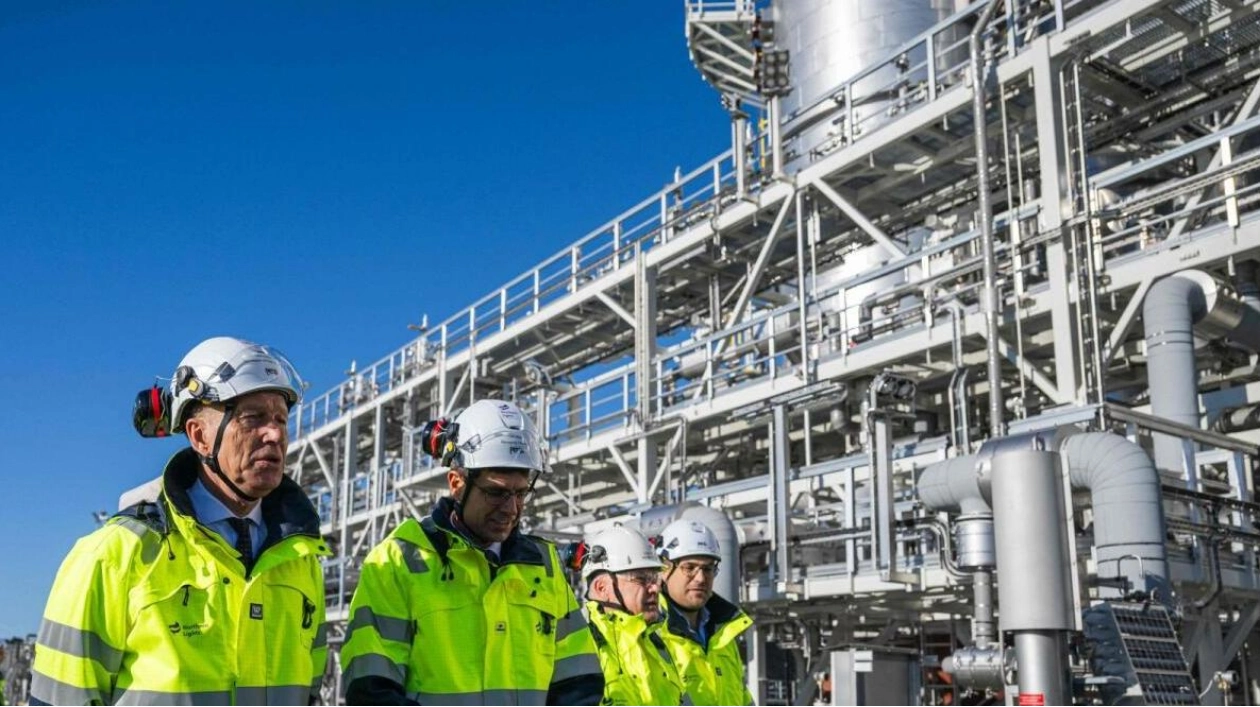Norway is preparing to inaugurate a significant gateway to an extensive undersea vault designed for carbon dioxide storage on Thursday. This marks a pivotal moment before the launch of what its operator describes as the first commercial service offering CO2 transport and storage. The Northern Lights project is set to capture CO2 emissions from factory smokestacks across Europe and inject them into geological reservoirs beneath the seabed. The primary objective is to prevent these emissions from entering the atmosphere, thereby contributing to the fight against climate change.
On the island of Oygarden, a crucial milestone will be celebrated with the inauguration of a terminal constructed on the shores of the North Sea. The terminal's gleaming storage tanks will stand tall against the sky, serving as the point where liquified CO2 will be transported by boat and then injected through a lengthy pipeline into the seabed at a depth of approximately 2.6 kilometers for permanent storage. This facility, a joint venture involving oil giants Equinor of Norway, Anglo-Dutch Shell, and TotalEnergies of France, is slated to commence its first CO2 deliveries in 2025. Initially, it will have a capacity of 1.5 million tonnes of CO2 per year, with plans to expand to five million tonnes in a subsequent phase if demand is sufficient.
"Our primary goal is to demonstrate that the carbon capture and storage (CCS) chain is viable," stated Tim Heijn, managing director of Northern Lights, in an interview with AFP. "It has the potential to significantly impact the CO2 balance and aid in achieving climate targets," he added. CCS technology, though intricate and expensive, has been endorsed by the UN's Intergovernmental Panel on Climate Change (IPCC) and the International Energy Agency (IEA), particularly for mitigating the CO2 footprint of industries such as cement and steel, which are challenging to decarbonize. According to the IEA, the world's current capture capacity stands at just 50.5 million tonnes, a mere 0.1% of global annual emissions. To limit global warming to 1.5 degrees Celsius since the pre-industrial era, the IEA estimates that CCS would need to prevent at least one billion tonnes of CO2 emissions annually by 2030.
The technology is still in its infancy and has progressed slowly due to high costs, particularly when compared to the price companies pay for CO2 emission quotas. As a result, it heavily relies on subsidies. "Public support has been and will continue to be crucial for advancing such innovative projects, especially given that CCS costs remain higher than the costs of CO2 emissions in Europe," noted Daniela Peta, public affairs director at the Global CCS Institute. The Norwegian government has funded 80% of the Northern Lights project's costs, which remain undisclosed. As Western Europe's largest oil and gas producer, Norway has identified the North Sea, with its depleted oil and gas fields and extensive pipeline network, as an ideal location for burying unwanted greenhouse gases. Several other undersea storage projects are also in development across Europe.
The Greensand scheme, being constructed off Denmark's coast by British chemicals group Ineos and 23 partners, is expected to begin operations in late 2025 or early 2026. In Italy, oil group Eni has partnered with gas transporter Snam to develop a facility off Ravenna. Northern Lights is part of a comprehensive 30-billion-kroner ($2.9 billion) initiative known as "Longship"—named after Viking ships—for which the state has provided 20 billion kroner. The plan initially included the establishment of two CO2 capture sites in Norway. While the Heidelberg Materials cement factory in Brevik is scheduled to start shipping its captured emissions to the site next year, escalating costs have prompted the waste-to-energy plant Hafslund Celsio in Oslo to reassess its plans. Northern Lights has also secured cross-border agreements with Norwegian fertilizer manufacturer Yara and energy group Orsted to store CO2 from an ammonia plant in the Netherlands and two biomass power stations in Denmark.
However, some environmentalists express concern that the technology could serve as a pretext for prolonging the use of fossil fuels and diverting funds that are essential for renewable energy development.






